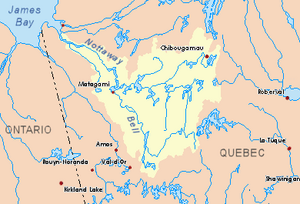Mégiscane River facts for kids
Quick facts for kids Mégiscane |
|
|---|---|

Watershed of Nottaway River
|
|
| Country | Canada |
| Province | Quebec |
| Region | Nord-du-Québec |
| Physical characteristics | |
| Main source | Françoise Lake (Mégiscane River) Senneterre, Abitibi-Témiscamingue, Quebec 470 m (1,540 ft) 48°07′15″N 75°39′50″W / 48.12083°N 75.66389°W |
| River mouth | Parent Lake (Abitibi) Eeyou Istchee James Bay (municipality),
301 m (988 ft) 48°29′00″N 77°08′00″W / 48.48333°N 77.13333°W |
| Length | 249.6 km (155.1 mi) |
| Basin features | |
| Tributaries |
|
The Mégiscane River is an important river in Quebec, Canada. It flows into Parent Lake (Abitibi). This river is found in the northwest part of Quebec, crossing through two main administrative regions:
- Mauricie, specifically the western part of La Tuque.
- Abitibi-Témiscamingue, in the area of Senneterre (parish).
The Mégiscane River is well-known in the Abitibi-Témiscamingue region. It's a popular spot for fishing, especially for sturgeon. The main activity in the area around the river is forestry, which means cutting down trees for wood. Tourism, like fishing and other outdoor fun, is also important. The river's surface usually freezes over from mid-December until the end of April.
Contents
River's Journey: Where it Starts and Flows
The Mégiscane River begins its journey at Françoise Lake (Mégiscane River). This lake is quite small, about 1.3 kilometres (0.81 mi) long, and sits high up at an altitude of 434 metres (1,424 ft).
From its source, the river flows through different areas:
- It starts in Senneterre.
- Then, it enters La Tuque, following the northern border of the Abitibi-Témiscamingue region.
- Along the way, it passes through several lakes, including Poète Lake, Rivas, and Tête.
- The river then returns to Senneterre, where it crosses more lakes like Pascagama, Canusio, Mégiscane Lake, Berthelot, and Faillon.
Finally, the Mégiscane River ends its long journey in Parent Lake (Abitibi), near Senneterre. In total, the river stretches for about 249.6 kilometres (155.1 mi).
Upper Mégiscane River
The first part of the Mégiscane River's journey covers about 43.1 kilometres (26.8 mi). From Françoise Lake, it flows north, passing through several smaller lakes like Madeleine, Roger, and Jean-George. It also crosses under the Canadian National Railway tracks.
Further along, it goes through Lake Octavia and Lake Chassiagne, near Eagle Mountain. It then flows through Lake Tower and Lake Bouillet, eventually reaching "Rat d'Eau Lake" (which means "Water Rat Lake"). This lake is fed by Provancher Creek. The river then widens as it crosses "Rat d'Eau Lake" itself.
An important feature in this upper section is the "Barrage de la Mégiscane" (Mégiscane Dam). This dam was built in 1954 at the outlet of Du Poète Lake. It's a very large dam, over 5,000 metres (16,000 ft) long, and helps control a huge amount of water.
Middle Mégiscane River: Lakes and Tributaries
After Du Poète Lake, the Mégiscane River continues for about 71.0 kilometres (44.1 mi) through its middle section. It flows north through Lake Rivas and Head Lake.
The river then turns southwest, meeting the Suzie River. It passes through the southern part of Pascagama Lake and meets the Kekek River. Further downstream, it crosses Ouiscatis Lake and Canusio Lake. This section of the river also flows through Mégiscane Lake.
Another part of the middle course, about 78.2 kilometres (48.6 mi) long, starts from Mégiscane Lake. The river flows southwest to Berthelot Lake, which receives water from the Berthelot River and the Macho River. It then meets the Achepabanca River.
The river continues southwest, crossing the northern part of Girouard Lake and joining with the Capousacataca River. It flows past Hubert Creek and eventually reaches the large Faillon Lake. The river crosses the entire length of Faillon Lake, which is about 2.2 kilometres (1.4 mi) wide. A forest road crosses a bridge at the end of this lake.
Lower Mégiscane River: Towards Parent Lake
The final section of the Mégiscane River, about 57.2 kilometres (35.5 mi) long, begins after Faillon Lake. It flows southwest, meeting the Collin River (Mégiscane River tributary).
Along this lower part, the river has two waterfalls and crosses the Canadian National Railway tracks again. It forms curves through marshy areas and is joined by Signay Brook and Sunday Creek. It also meets the Tavernier River.
The Mégiscane River finally flows into the eastern shore of Parent Lake (Abitibi). This meeting point is about 13.5 kilometres (8.4 mi) north of downtown Senneterre.
River's Name: What it Means
The name "Mégiscane" comes from an Algonquin word, either metshishkan or mesiskine. It means "hook." This name likely refers to how good the river is for fishing.
Older maps show different names for the river. An 1898 map called it the "Mekiskan River." A geological map from 1935 used the name "Monet River." The official name, "Mégiscane River," was formally recognized on December 5, 1968, by the Commission de toponymie du Québec, which is like a naming committee for places in Quebec.
Power from the River: Hydroelectricity
In the 1940s and 1950s, a company called the Shawinigan Water and Power Company studied how to use the Mégiscane River to create electricity. They wanted to send some of its water to other rivers that had hydroelectric power plants.
In 1951, the Government of Quebec allowed part of the Mégiscane River's flow to be diverted to the Saint-Maurice River basin. A dam was built in 1954 in La Tuque. Another dam and a canal were also built to help send water from the Mégiscane River to the Gouin reservoir. This water then helps power hydroelectric dams on the Saint-Maurice River.
This project helped increase the amount of electricity produced by plants like Rapide-Blanc, Trenche, and La Tuque. The whole project cost about $14 million and added a lot of power, around 120 megawatts (160,000 hp), to the company's system.

